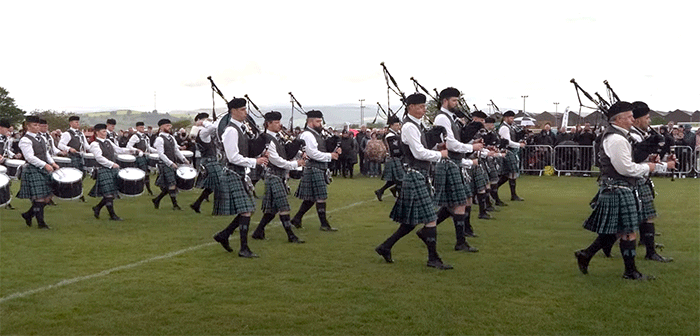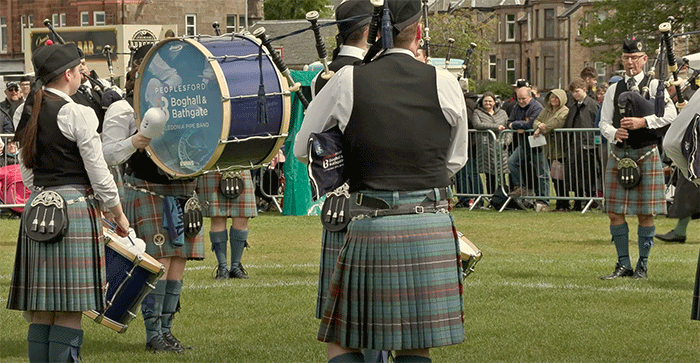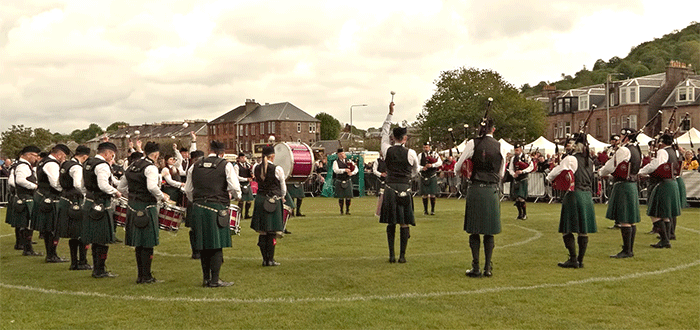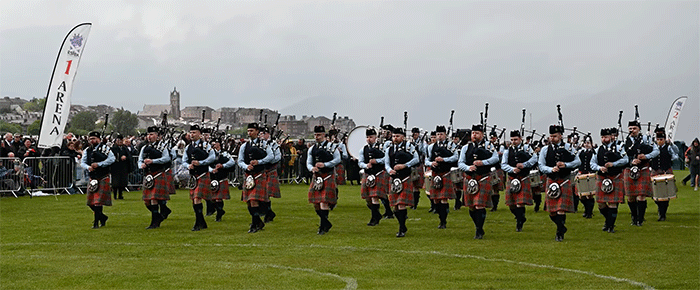
It was a relief to be able to attend the British Championships at Greenock last Saturday, the first time I have been anywhere near a live pipe band contest for more than two years. The venue was perhaps appropriate for the first Major following the pandemic as Battery Park is on the Firth of Clyde, not far from where, on the ferry coming back from Cowal in 1930, the original idea of the then the Scottish Pipe Band Association was conceived.
One oddity which occurred to me was that Battery Park was publicised as in Greenock for the British Championships whereas when the same park hosted the local Glasgow and West of Scotland competition two weeks ago it was advertised as Gourock. I can only assume that the park sits on the boundary of the two towns.

By Alistair Aitken OBE
Battery Park was in fact an ideal location for the Championships, first held at Renfrew in 1948, as it offered plenty space, and gone were the competing noises from aeroplanes and motorway traffic experienced at the former venue at Paisley. Unfortunately the day was marred by intermittent rain and a significant breeze.
Despite the absence of the Championships for the past two years the various contests in the different grades ran like clockwork to the normal RSPBA high standards of timing and organisation. My only concerns from a spectator perspective were that you had to be very selective in the grades you focused on if you wanted to hear a full competition as various contests were running at the same time.
‘Some spectators take up valuable space by claiming their territory well in advance … by putting camping chairs in place. It is even worse when they raise their large brollies … and block the view … and the rain then starts to run off … on to those same spectators….
As often happens at Major Championships there were also overlapping sounds between different competition rings. The Grade 1 contest was affected by sounds from bands in the final tuning area (the direction of the wind not helping that). There was, however, space to widen out the competing areas more at this venue to overcome some of these problems. Another problem for spectators is that space is naturally limited around the competing rings if you want to listen closely.
This is not helped when some spectators take up valuable space by claiming their territory well in advance of the start of a popular competition like Grade 1 by putting camping chairs in place thus restricting the space for everyone else. It is even worse when they raise their large brollies when it starts to rain and block the view of those behind; and the rain then starts to run off the brollies on to those same spectators. In my adjudication days I did a lot of research into the barriers experienced by adjudicators. There are just as many for the spectators!!
I only had time to listen intently to the Grade 1 competition. I stood to the left of the top of the playing circle, as I always like to listen to how the drumming projects through the piping. In my view that is where you can make a more balanced assessment of the collective ‘pipe band’ in terms of sound balance as well as technical and musical aspects. Most ensemble adjudicators tend to operate at the head of the band circle. Listening from behind the drummers in my view gives an entirely different impression of the band balance (pitch and weight) as you are hearing the piping coming through the drums.
The following represents my general views but I must emphasise that they are personal ones and some of the performances were influenced by sounds from elsewhere. It is also not easy to make any detailed notes among a crowd of spectators in such inclement weather. Much of what follows has had to rely on memory retention and it would not be the first time that I have been accused of having hearing deficiencies!! My observations are in the order in which the bands actually played and intentionally I have not stated who I thought the winners should be. That would be unfair to the adjudicators and in fact the bulk of this article was drafted on Saturday night and Sunday morning before the results were published.
Closkelt: It is unfortunate that the band was drawn to play first at its first Major following upgrading to Grade 1. Nevertheless they set a very high standard with a solid performance and a good balance of sound between pipes and drums. The clarity of the piping sound was outstanding. While the bass section made some very musical contributions, from where I was standing I thought the snare drumming came through rather intense and did not project clearly through the pipes There were also some minor integration issues between pipes and drums at times. In my view there is still scope for a more subtle approach by the snare drummers.
Field Marshal Montgomery: Typical FMM big sound, classic drone sound and excellent balance between pipes and drums. A well-constructed medley as is always the band’s hallmark. The execution as a band came across as immaculate, with positive and natural transitions between tunes throughout and with excellent musical presentation and impact. The skill of the band is innovative interpretation of mainly traditional tunes. The final tunes were played very fast with pristine precision, with the obvious intention of finishing on a high which was achieved. My only minor comment was an impression that the tempo seemed to increase slightly towards the end. Overall a very strong performance with composure, excitement, rhythmic flow and musical effect.

Boghall and Bathgate Caledonia: Although arguably the overall sound was not as powerful as FMM, this performance nevertheless was another example of an excellent balanced sound between pipes and drums. The medley flowed well between time signatures with superb musical interpretation as a combination of pipes and drums. All sections of the drum corps projected through clearly, were well balanced and the interpretation of the drum corps added significantly to the overall musical effect. The playing of the band collectively came across as relaxed, confident and musical even though at times some of the tempos were just on the edge.
St Laurence O’Toole: Another very musical performance from the outset assisted by the effective interpretation of all sections of the drum corps. The clarity of the drumming projected through very well. Where I was standing the snare drum sound came across rather ‘hard’ with little snare response (which I accept may have been different from the back of the corps) and this, for me, affected the balance of sound between pipes and drums. The final tune also came across to me as a rather complicated set of harmonies which resulted in the actual melody being lost at times. Overall a very dynamic performance in the band’s own traditional musical style.

Shotts and Dykehead Caledonia: A well balanced sound but perhaps not as powerful as other bands, and generally the snare drumming did not project through the pipe corps clearly. At times the drumming was rather intense with scope for more subtle playing. Piping precision was perhaps affected by the accuracy of some of the harmonies. The playing seemed to become rather controlled towards the latter stages which lost the rhythmic flow a bit, but things improved after the break into the Little Cascade. The first two parts had excellent clarity and precision effect but in the final stages the harmonies seemed to me overdone at the expense of the actual melody. But I am biased as this was one of the classic tunes of the Edinburgh City Police Pipe Band when I played in it!
Scottish Power: Once again the snare drums did not project through the pipes clearly where I was standing but nevertheless the drum corps in general had a major impact on the musical interpretation of the band. The sound balance between pipes and drums was very good, with a very powerful piping sound. The opening tune was played very fast and there seemed to be slight integration problems between pipes and drums until the band had settled into the circle. I particularly liked the overall band effect in the slow air (pibroch). The playing seemed to become a little too controlled towards the end but overall another strong performance both technically and musically.
Johnstone: The balance of sound for me was affected by a hard/harsh drum sound which lacked snare response and clarity of sound projection. In general the rhythmic effect from the band was good. The break to the jigs seemed rather fuzzy between pipes and drums. From where I was standing, I thought the band’s overall musical impact could be improved with more dynamics and weight variation from the snare drummers. However, I did like the natural dance rhythm achieved in the strathspey playing.

Police Scotland Fife: This I thought a very strong performance. The sound balance between pipes and drums was excellent as was the clarity of the playing in general. The drum corps in general, including the very subtle bass section, projected through the pipes very well, and the drum corps enhanced significantly the band’s innovative musical interpretation. The band has lost nothing from a two-year absence and a change of leadership.
Inveraray and District: For me the band had an excellent balance of sound between pipes and drums as well as very relaxed and fluent execution despite some of the tempos being just on the edge. But they were well sustained. Another band with very effective interpretation of traditional tunes and the medley was well constructed with seamless transitions. The overall effect was dynamic with excellent musical effect, ably assisted by the subtle interpretation of the drummers, including the bass section. Even in my position at the head of the band I did not miss the innovative back-sticking by the snare drummers towards the end. Brilliant!!
Police Scotland and Federation: Unfortunately I did not hear the full performance as by that time the contest was running about 5-10 minutes late and I had to run to catch my train home to avoid the football fans at Glasgow Central station returning home from the Scottish Cup Final. The start of the performance was very brisk and the snare drumming projected through rather intense and forced. The performance settled better when the band reached the playing circle by which time the overall band sound seemed well balanced, but the drumming still came across as rather forced. It would be unfair for me to make further comment without hearing the full performance.

General Conclusions: Overall the experience of the day proved to be an interesting return to outdoor competitions for the RSPBA. What is unfortunate is that the legacy of the past two years reduced the number of entries, but hopefully things will improve as the season progresses. Thankfully my impression from the Grade 1 competition was that the top bands do not appear to have suffered greatly from the pandemic and the opportunity has been taken to embark on new and innovative medleys. It remains to be seen what will happen when the playing requirements change to march, strathspey and reel. Clearly, however, there is healthy competition at the top level for the championships which lie ahead.
Finally a few words about the competition as a spectacle. When viewed from the spectators the Grade 1 bands are very impressive due to their size. In general the marching and deportment into the competing circle was very smart and accurate. A niggle of mine, however, is the number of players who stand for the whole performance with their feet widely apart. Some will claim that this does not matter as only the playing is important. The M&D does matter as the top bands are the role models for those watching from the lower grades, particularly the young players at the early learning stage.



















A very helpful and informative critique of the day.
Thanks for posting.
The rising amount of players with their “legs wide apart” is a sign of an up and coming generation with little or no contact to army related drills. They stand in a way they feel comfortable just as members of symphony orcestra sit. The latter are not expected to sit to attention. For me it’s a welcome sign of a departure from the strictly army attitudes apapted by civilian pipe bands to a focus on music and performance so far never matched by any army band.
As a Greenockian who now lives in Gourock, I am able to confirm that Battery Park is most definitely in Greenock. The boundary with Gourock is just beyond the west end of the park.
The confusion for Alistair may be that the Gourock Highland Games are now held in Greenock – at the Battery Park in – rather than Gourock Park where they used to be held. The latter are sponsored by Inverclyde Council. The change was made a few years ago. It was felt that Battery Park is a better venue for the bands than Gourock Park and it most definitely is.
Both Gourock and Greenock are in Inverclyde.
To clarify the geographical question of a piping competition being held in the same venue two weeks apart, but being promoted as being in different towns, my understanding is as follows:
The Battery Park is in Greenock and it is the western boundary before you enter Gourock. Therefore, the British championships were held in Greenock.
Two weeks earlier the Gourock Highland games, which have been held for many years, were held at the same venue i.e. Greenock. However, for a significant number of years ago, theses games were held in Gourock, but at a venue, which had bad drainage etc. and they were moved, without a name change, to Greenock , one of their sister towns in overall area known as Inverclyde.